A Texas Butterfly Ranch survey conducted in late 2014 found that Monarch butterfly enthusiasts are willing to put extra money where their beloved Monarch caterpillars mouths are: on clean, chemical-free (preferably native) milkweed.
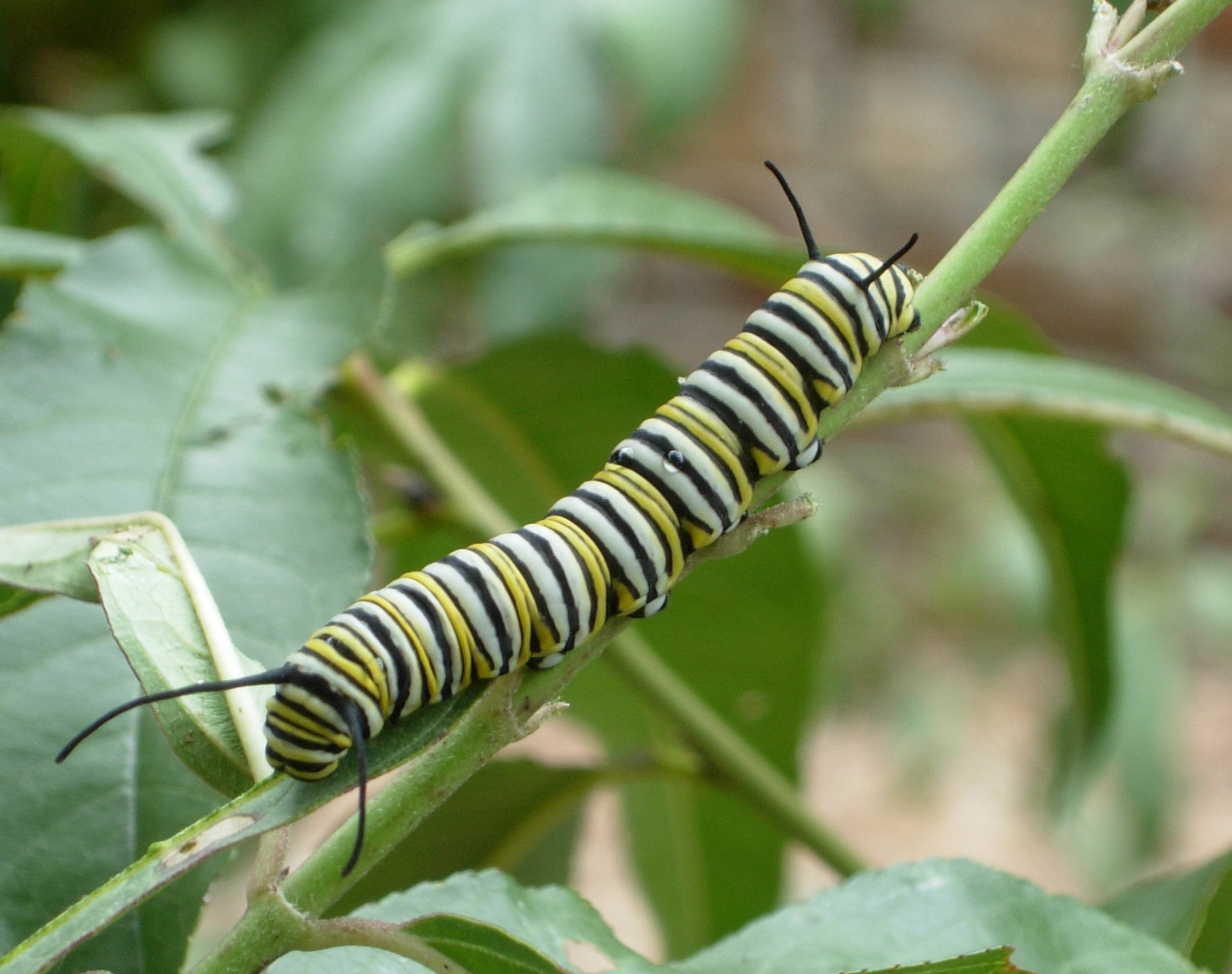
Got clean milkweed? Great, we’ll pay more. Is it native? Yes, please–even better. Photo by Monika Maeckle
Are you listening, American nursery industry? You can make more money if you grow milkweed without chemicals. Make them native and you can likely charge another premium.
“Truthfully, I’ll pay anything to keep my cats safe!”
Our online poll of 363 respondents found that 96% responded “Yes” to the question: “Would you pay more for “clean,” chemical-free milkweed that is raised organically, sustainably and locally?”
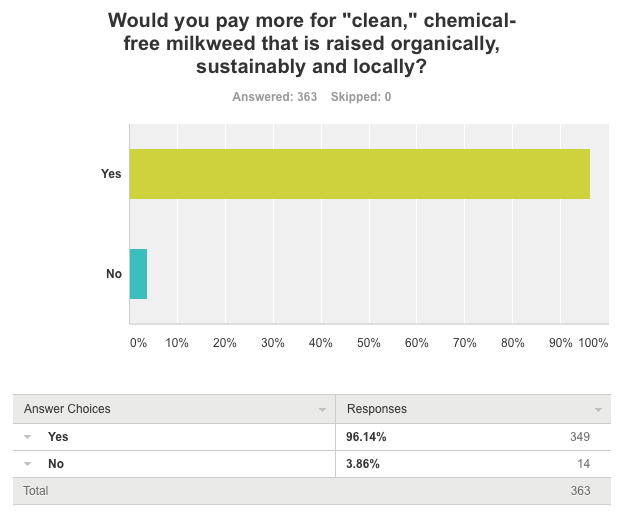
The survey, which ran in various online forums from September 24 through December 31, 2014, resulted from the annual angst that arrives with each fall migration. Late in the season, when masses of Monarchs move through town and some lay eggs on local milkweed plants, those who hope to raise the caterpillars to the butterfly stage bring them inside for “fostering.” It’s not uncommon so late in the year for people to run out of milkweed for their hungry caterpillars.
This typically sends folks running to their local nursery to buy fresh host plant–most often Tropical milkweed, Asclepias curassavica, since that’s all that’s commercially available. Typically, when asked the provenance of the milkweed, nursery staff tell milkweed buyers the plants have NOT been sprayed with pesticides.
“When my caterpillars are down to stems, I’m just happy to be able to get ‘clean and safe’ milkweed at almost any price….They will starve otherwise! I’ve bought ‘bad’ milkweed and lost thirty or more caterpillars… it was horrible.”
Yet, upon moving their Monarch larvae to the milkweed plants, the caterpillars perish within hours. That’s because many commercial growers use systemic pesticides to keep the plants aphid-free before selling them to our local nurseries. Often the local nursery staff is unaware that these pesticides have been sprayed on the plants. Nor do they seem to know that the chemicals remain active for months.
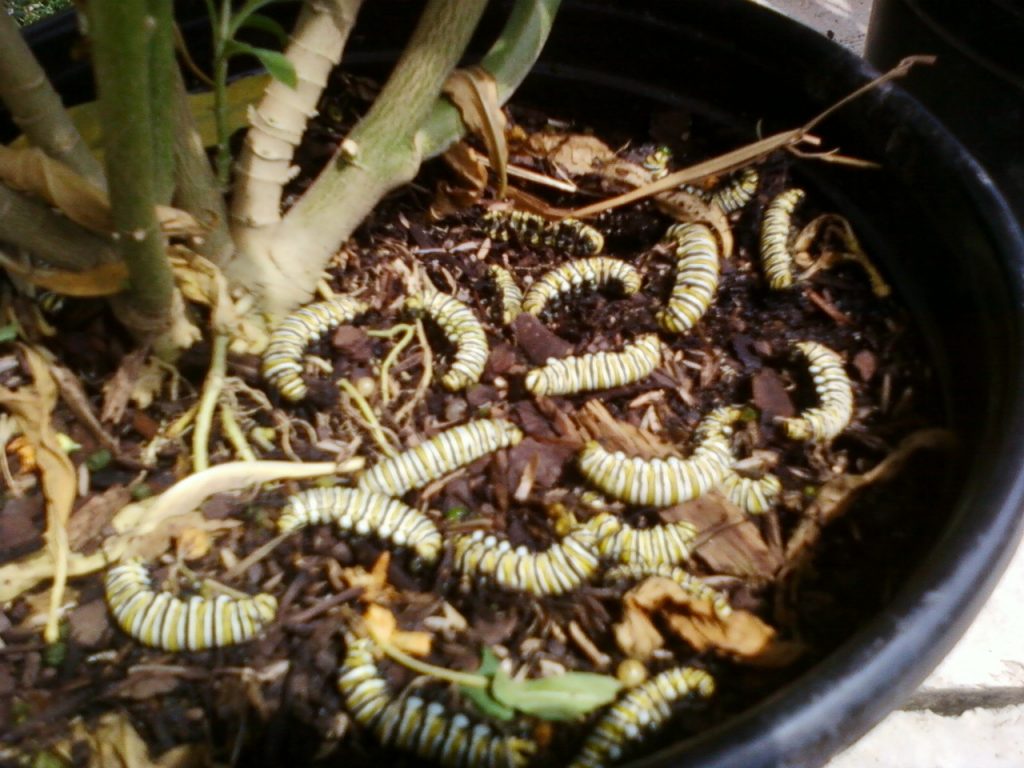
Always a bummer: dead Monarch caterpillars fall victim to pesticide laced milkweed. Photo by Sharon Sanders
The syndrome has been dubbed by those of us who follow it Desperately Seeking Milkweed and has been well documented on this website as well as referenced in comments (some of which you’ll find throughout this post) in our recent milkweed survey.
So how much, exactly, are Monarch caterpillar foster parents willing to pay for clean, chemical free milkweed?
“I grow my own plants but when I run out of food I have to run to a garden center…I always ask, ‘have these plants been sprayed with insecticide?’ and the answer is always ‘No, ma’am.’ I buy the plants and my cats die when they eat it…very sad so I would definitely pay more to keep my babies alive! 🙂 “
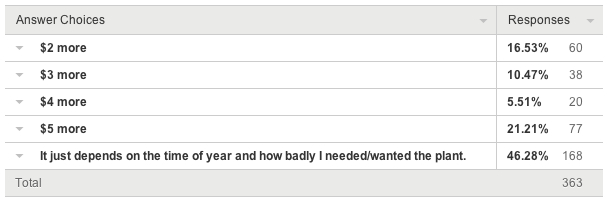
About 48% said “it would depend” on the time of year and how badly they wanted/needed the plant. Another 21% of respondents said they would pay $5 more, 5.5% said $4 more would be their limit, 10.5% said they would pay $3 more and 16.5% said they would pay $2 more.
The geographic diversity of the respondents played out like this:
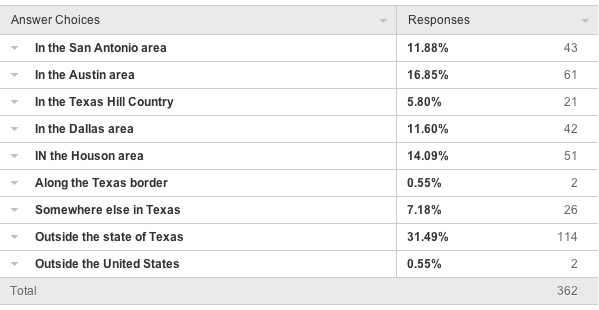 Missing from the survey was a question asking whether or not buyers of milkweed prefer that NATIVE species in addition to chemical free and clean. My bad. Of the 183 comments, many expressed a desire for NATIVES. Here’s a sampling of comments:
Missing from the survey was a question asking whether or not buyers of milkweed prefer that NATIVE species in addition to chemical free and clean. My bad. Of the 183 comments, many expressed a desire for NATIVES. Here’s a sampling of comments:
“NATIVE, clean milkweed please.”
“Prefer the non-tropical, if possible… Native Texas milkweed would be preferred.”
“Is there any place to buy native milkweed plants?”
“Native milkweed is hard to find in the nursery trade. I’m rich, but I would pay a fair price.”
“What about native milkweed?”
The survey launched about a month after an August 26 petition to list the Monarch butterfly as “threatened” under the Endangered Species Act made its way to the Department of the Interior. That petition is under a 12-month review and has provoked many discussions about the gross loss of native milkweeds in our landscape in addition to a lack of available native milkweeds in commercial nurseries.
Since, interest in native milkweeds has ballooned, bringing much needed attention to Monarch butterfly native habitat restoration in our fields, landscapes, gardens–even in our caterpillar nurseries in the late fall during the migration as well as in the spring.
So listen up, commercial growers. Native milkweeds are in high demand and short supply. A business opportunity awaits those who pounce. The Texas Butterfly Ranch is exploring such a venture with our hydroponic partner, Local Sprout. Stay tuned for details.
Related posts:
- MIlkweed Guide for Central and South Texas
- Monarch Butterfly News Spurs EXTREME Interest in Native Milkweeds
- Endangered Species Act Wrong Tool for the Job of Monarch Butterfly Conservation?
- How to Get Native Milkweed Seeds to Germinate
- Monsanto: Absolutely committed to Monarch Butterfly Conservation
- Native American Seed and the Challenges of Persnickety Texas Native Milkweeds
- It Takes a Village to Feed Hungry Monarch Caterpillars
- Desperately Seeking Milkweed: Milkweed Shortage Creates Butterfly Emergency
- Llano River Ready for “Premigration Migration” of Monarch Butterflies
- Pollinator Power on the San Antonio River Walk
- 2014 Monarch Butterfly Migration: Worst Year in History or Hopeful Rebound?
- How to Raise Monarch Butterflies at Home, Part One
- First Lady Michelle Obama Plants First Ever Pollinator Garden at the White House
- Monarch Butterfly Numbers Plummet: will Migration become Extinct?
- NAFTA Leaders, Monsanto: Let’s Save the Monarch Butterfly Migration
Like what you’re reading? Follow butterfly and native plant news at the Texas Butterfly Ranch. Sign up for email delivery, like us on Facebook, or follow us on Twitter, @monikam.

Here’s a link to a 2013 study that shows people are willing to pay a lot to support monarchs:
http://www.usgs.gov/newsroom/article.asp?ID=3712&from=rss#.VDQ5Qee0Hxt
“Americans place high value on butterfly royalty. A recent study suggests they are willing to support monarch butterfly conservation at high levels, up to about 6 ½ billion dollars if extrapolated to all U.S. households.
If even a small percentage of the population acted upon this reported willingness, the cumulative effort would likely translate into a large, untapped potential for conservation of the iconic butterfly.
Monarch butterfly populations have been declining across Mexico, California and other areas of the United States since 1999. A 2012 survey at the wintering grounds of monarchs in Mexico showed the lowest colony size ever recorded.
“The multigenerational migration of the monarch butterfly is considered one of the world’s most spectacular natural events,” said Jay Diffendorfer, a USGS scientist and the study’s lead author. “However, managing migratory species is difficult because they can cross international borders and depend on many geographic areas for survival.”
Much of the decline in monarch numbers has been blamed on the loss of milkweed, the native plants on which monarch caterpillars feed.
“While many factors may be affecting monarch numbers, breeding, migrating, and overwintering habitat loss are probably the main culprits,” said Karen Oberhauser, a monarch biologist at the University of Minnesota and a co-author of the study. “In the U.S., the growing use of genetically-modified, herbicide-tolerant crops, such as corn and soybeans, has resulted in severe milkweed declines and thus loss of breeding habitat.”
The authors suggest that the universal popularity of monarchs could encourage a market for monarch-friendly plants….”